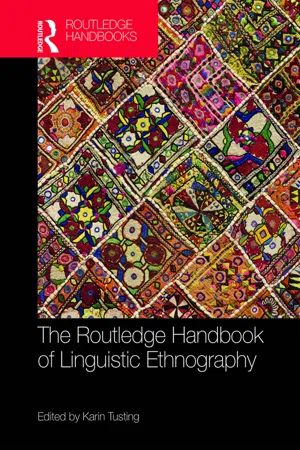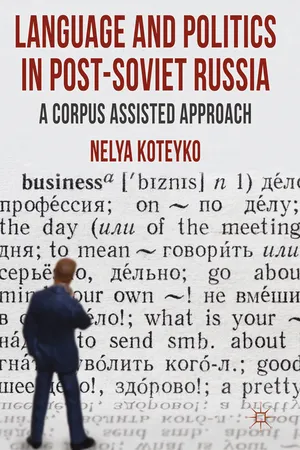Languages & Linguistics
Sinclair and Coulthard
Sinclair and Coulthard's work focuses on the analysis of spoken discourse, particularly in the context of classroom interactions. They introduced the concept of "initiation-response-feedback" (IRF) sequences to describe the structure of teacher-student interactions. Their research has been influential in the field of discourse analysis and has contributed to our understanding of the dynamics of spoken language in educational settings.
Written by Perlego with AI-assistance
Related key terms
1 of 5
3 Key excerpts on "Sinclair and Coulthard"
- eBook - ePub
- Nikolas Coupland(Author)
- 2016(Publication Date)
- Taylor & Francis(Publisher)
Chapter 9 ) draws on what has come to be established terminology to identify hierarchical levels of functional organisation - 'moves' and 'acts'. Sinclair and Coulthard's schema has, with minimal modification, been applied to social settings beyond the classroom, for example in Coulthard and Ashby's analysis (mimeo) of doctor-patient inter action, and my own work on travel-agency talk (Coupland 1983). We might predict in fact that the principal functional 'levels' at which Sinclair and Coulthard have shown classroom talk to be organised - transactions, exchanges and moves - will be rele vant in most 'transactional' (as opposed to 'personal', in Gumperz's senses of these terms) encounters and that similar patterings - e.g. of exchange structure - will tend to recur.The important observation for our current interests, though, is that analyses of this sort are primarily motivated by concerns about descriptive linguistic adequacy rather than aspiration to social explanation. Though contextual/sociological insights will derive from analysis of this sort - leading to rather predictable conclusions, for example, about the distribution of power in the classroom through variable constraints on amounts and types of communicative contribution - the analysis is designed to display linguistic regularity. The classroom setting, as Sinclair and Coulthard acknowledge, is well suited to their analytic procedures (not vice versa) because of the rigid scripting that at least some school settings impose upon spoken interchange; their classroom discourse has 'structure and direction' (1975, p. 5). Though the units of analysis are not formal; the analysis is not essentially different from those of clause-level constituent-analysis, establishing criteria for segmentation and classification. Discourse itself is characterised as a further rank above the clausal rank at which structure is discoverable.Another major strand of British linguistic studies - systemic linguistics - integrates 'discourse' focally into its theory and description. A moderately uncontroversial representation of the Hallidayan framework (though the precise distribution of categories and delimitation of descriptive planes and levels is a matter of considerable ongoing debate - cf. Halliday 1978, 1984; Halliday and Martin 1981; Greaves and James 1984) will view language as a tri-stratal system, comprising phonology, lexico-grammar and thirdly discourse. Discourse here broadly equates to core areas of the semantic/pragmatic components of alternative descriptive formulations, and is the stratum within which such sub-systems as reference, conjunction, cohesion and conversational structure may be specified. For example in Martin's (MS) account, discourse handles dependency relations between parts of a text. I shall return to Hallidayan accounts of the relationships between language and context and their discussions of register, genre and ideology a little later, where we shall find a discussion far more centrally relevant to the concerns of this book. For now the point is that systemic linguistics again adopts an orientation to discourse which seeks primarily to enrich the descriptive (and in this case also the predictive) adequacy of linguistic theorising. Halliday's theories are sociolinguistic theories to the extent that they work dimensions and categories of the social functioning of language into a systemic account of how language constructs meaning, the drift of argumentation therefore being from sociological to linguistic. - eBook - ePub
- Karin Tusting(Author)
- 2019(Publication Date)
- Routledge(Publisher)
Attending to the first area of definition, the development of a scientific object referred to as ‘discourse’ resulted in a major breakthrough in linguistics’ efforts to unravel the nature of naturally occurring language use and to do so with specific reference to formal-functional properties characteristic of running text and ongoing interaction, as well as locating areas of meaning relative to situation, purpose and user. It is worth reminding readers here that some instances of early discourse research prioritised the conversational domain of spoken exchanges, while other early developments focussed more on the properties of written texts. Anglo-American work, in particular, interacted directly with speech act theory and conversation analysis and was quick to integrate key concepts from these fields – e.g. turn, sequence, speech act, speaker intention, etc. At the same time, examples in this tradition such as Sinclair et al. (1972) on classroom interaction, Labov and Fanschel (1977) on psychotherapeutic encounters and Brown and Yule’s (1983) discourse analysis textbook were still very much bracketed by fairly traditional linguistic concerns such as the detection of a hierarchical structure in speech events in ways akin to what had been described earlier for the constituents of the sentence. Corresponding continental European work, which often identified itself as ‘text linguistics’, focussed on descriptions of the functional components of structure beyond the sentence level and the ways in which textual make-up is tied to situation of use (e.g. anaphoric, cataphoric and situational reference; constituents of argumentative and rhetorical structure; devices to accomplish textual cohesion and establishing textual coherence, etc.), as well as on the cognitive processing of textual units. In each of these cases, the impetus was to push the linguistic agenda beyond the confines of the isolated sentence, locating the text in its contexts-of-use. Well-known examples include Harweg (1968) on reference, Werlich’s (1976) text grammar of English, De Beaugrande and Dressler’s (1981) identification of seven standards of textuality and Van Dijk and Kintsch’s (1983) work on the processing of textual information. - eBook - ePub
Language and Politics in Post-Soviet Russia
A Corpus Assisted Approach
- N. Koteyko(Author)
- 2014(Publication Date)
- Palgrave Macmillan(Publisher)
Whereas the synchronic (structuralist) approach focuses on language as a system of meaning, where the emphasis is on the actual, the repetitive and the systematisable, the approach introduced here adopts a diachronic perspective on the exchange of meanings within particular contexts and discourses. In this regard, corpus linguistics offers a framework in which interpretation is based on a detailed study of intertextual links in a chronologically organised collection of texts. 2.1 Approaches to discourse and discourse analysis The concept of discourse in linguistics and social sciences For the past three decades, the concept of discourse has undoubtedly played an increasingly important role in social sciences and humanities. The term implies a complex link between linguistic and social spheres, and different approaches construe this relationship on different terms. Currently, the notion is employed across a range of disciplines, and can mean ‘something as specific as spoken language, or something as general as the social process of communication’ (Lemke, 1995: 6). This led Widdowson (1995: 169) to suggest that discourse has been used so widely that it no longer has any definable meaning. In linguistics, for example, at least two definitions of the term have been elaborated: discourse as language above the sentence level, and as language in use. 1 Typical linguistic studies in this tradition examine how lexical and grammatical forms take on meanings in particular contexts, by paying attention to speaker/writer intentions, conversational rules and maxims, and various ways of analysing inferences. The view of context in such approaches excludes social and political forces behind all communicative acts, which made Pennycook (1994: 118) describe such analyses as ‘decontextualised’
Index pages curate the most relevant extracts from our library of academic textbooks. They’ve been created using an in-house natural language model (NLM), each adding context and meaning to key research topics.


